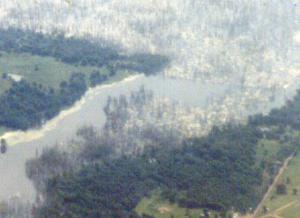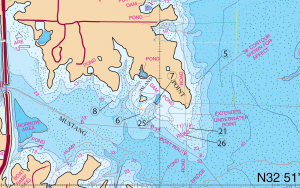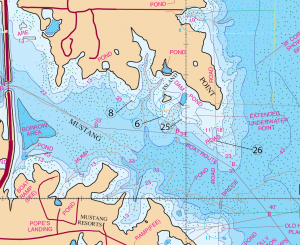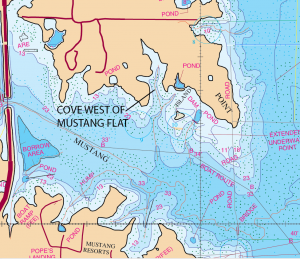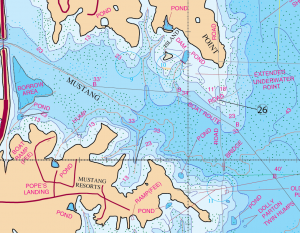Location #6, #8, & #25,
Big Mustang Flat-
“An Important Flat”
Timing: Year Round Use.
Location: #6, #8, & #25.
This area is located on the north shore of Big Mustang Creek at the entrance point. This area (#25) includes a large flat, an island, a roadbed (#26), some creek channels (or guts) and several protruding points (#6) & (#8). Most of these locations in here contain some serious shell beds in here. I would suggest that you review the Mike McFaland video before fishing this (linked above near the title of this article). This location requires that you have some very definite criteria s before fishing shell beds works in here. #26 – This area is very similar to “the flat” that we discussed in detail earlier at the Electric Ladyland site. This is a rather large flat which posses numerous viable structures. These structures are the very reasons that allow Big Mustang Creek to be fished effectively year round.
Description: The table top portion of this spot #25
Essentially the top of this structure acts like one big tabletop covered with water especially when it has some very good grass. This tabletop has two guts that lead directly to the main body of this pond/cove. This spot has four body points and an open waterside hump (hump to the Far East-location #26). These spots provide for some great feeding areas for bass. Hump #26 is just on the east side of the old Hwy 17 road. This area does not provide much wind protection. However, often there is a wind pattern that pushes the bait fish into the cuts and up on the flat. Bass will often travel up these guts and the roadbed. Sometimes they will get up on the flat and flush the bait fish that hold in patterns around these little humps, the four points, the roadbed and the open water hump. When the bait fish group in this area they are prime targets for an ambush by big fish here. It is no surprise that more often than not you will see a boat fishing this location #26. This area is one of those year round productive fishing places.
Timing: Year round. Let the water temperature tell you what to do. Just fish this area with a lure that you have some degree of confidence in.
What to do: Below is a table which you can usually go by. A rule of thumb if you wish.
Water Temperature Lure Type
If the water temperature is below 52 degrees use Jigs or spoons
If the water temperature is 52 Degrees use a Red Rattle Trap
If the water temperature is 55 Degrees use Chartreuse Spinner Baits
If the water temperature is 60 Degrees Jerk Baits, Super Flukes, Lizards
If the water temperature is 64 Degrees and you’re on Bed Fish – use hot pink, bubblegum lizards Texas or Carolina rigged lizards or use a white lizard dipped in a yellow Dip and Glo to help you see better when the fish actually takes the bait.
If the water temperature is 70-72 Degrees use Crank or Top Water Baits
If the water temperature is 80 Degrees plus use Carolina Rigs or Top Water Baits
Very important! When the wind blows into this area. If the wind is still blowing into this area the smart move is to throw moving baits such bass crank baits, rattle traps, spinner baits, or buzz baits. The rule of thumb is to let the water temperature help you select your lure. If the wind is now blowing opposite from what it was for the last three days and you are fishing “slick” water (flat water with no ripple) throw slower moving baits such as worms, Jigs, lizards, super flukes, and top water baits. Use a stop and pause type presentation.
The picture shown below is the mouth of Mustang Creek. Elevation 388.55. 14.45′ below normal pool level. The view is looking northeast. The protruding green part of this, mid-picture, sticking out from left to right is the location #26 which sits exposed, out of the water. Notice the amount of available timber before inundation at this spot. If you look closely you can see the old Hwy 17 road’s path following from left to right in the picture. Here you have deep, main-lake open water, close to this great point next to this very nice flat. These fish migrate out of the deep water and isolate their food in these shallow water areas around this point and the others at locations #8 & #6 and around the flat.
